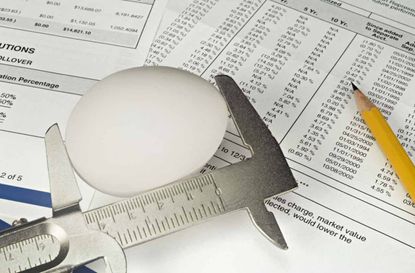How Should YOU Measure Your Investment Performance?
Investors shouldn't be obsessed with their portfolio's performance, but an annual evaluation is key to keeping you on track.


I’ve spent over 25 years in the financial advisory profession but recently had a startling realization about investment performance. During a friendly debate with a friend who manages a small-cap mutual fund, I realized even seasoned investment professionals can have misperceptions about investment performance. My friend had a fixation on top quartile performance, a key measure of his professional ranking, but one with little application in the real world — where clients typically own mutual funds representing various asset classes.
Our debate got me to thinking: How should the average investor measure investment performance? I recommend investors focus on two components of performance:
How is my performance number calculated?

Sign up for Kiplinger’s Free E-Newsletters
Profit and prosper with the best of expert advice on investing, taxes, retirement, personal finance and more - straight to your e-mail.
Profit and prosper with the best of expert advice - straight to your e-mail.
How is my account doing relative to a fair benchmark?
Your Performance Calculation
The performance calculation methodology involves two key variables: 1) the mathematical formula used to produce a return figure and 2) the portfolio(s) that are being measured. Most professional money managers use a Global Investment Performance Standards (GIPS) compliant methodology to calculate investment performance. Brokers, Registered Investment Advisers and custodians often provide performance information to clients in their account statements. It is important to ask your provider if their performance report uses an approved GIPS methodology. Time-weighted returns are the most commonly used measure.
Interestingly, GIPS does not require investment performance to be reported net of fees. Consumers would be wise to ask their adviser for performance reports net of fees. After all, it’s not what you earn, it’s what you keep that is important.
Equally important is understanding whether the performance number is specific to your account, or merely a listing of the performance of each mutual fund. According to the GIPS guidance statement on fees, “The GIPS standards are based on the concept of presenting composite performance to prospective clients rather than presenting individual portfolio returns to existing clients (emphasis added).” Very simply, it is permissible for a broker or custodian to show a performance number on your statement for XYZ mutual fund that may or may not be your actual investment performance.
I’ve seen brokerage statements list a client’s various mutual fund’s performance, but not include the client’s overall account performance. Investors should ask their adviser for their specific account’s performance net of all fees. Most advisers have software that can calculate this.
Which Benchmark to Use
What about benchmarks? How can investors gauge their performance relative to other alternatives? This simple question raises many issues.
Should you benchmark your portfolio versus an index like the S&P 500? What’s a fair comparison for a portfolio invested 65% equity / 35% fixed? What about an all-equity portfolio comprised of large-cap, small-cap, international, REITs and emerging markets?
Morningstar provides a quarterly list of average returns by category, which is a reasonable basic benchmark to measure a specific fund. For accounts using a diversified, multiple asset class approach, Morningstar provides returns for different asset allocation funds, sorted by equity ranges. This is a helpful guide should your portfolio be comprised of large-cap, small-cap, international and emerging market funds.
The Bottom Line
While an obsession with performance can be counterproductive (often leading to chasing past winners and inferior performance), an annual review of portfolio performance is something all investors should undertake. Make sure you understand what is being measured and how it is being measured so you can track progress toward your goals.

Mike Palmer has over 25 years of experience helping successful people make smart decisions about money. He is a graduate of the University of North Carolina at Chapel Hill and is a CERTIFIED FINANCIAL PLANNER™ professional. Mr. Palmer is a member of several professional organizations, including the National Association of Personal Financial Advisors (NAPFA) and past member of the TIAA-CREF Board of Advisors.
-
 It’s Tax Day: Is the Post Office Open Late?
It’s Tax Day: Is the Post Office Open Late?Tax Filing Tax Day is here and some people need to mail their federal income tax returns.
By Kelley R. Taylor Published
-
 Need to Build an Emergency Fund? Seven Steps to Get There
Need to Build an Emergency Fund? Seven Steps to Get ThereHaving a safety net can mean peace of mind on top of being able to maintain your lifestyle if a financial emergency strikes.
By Justin Stivers, Esq. Published
-
 Need to Build an Emergency Fund? Seven Steps to Get There
Need to Build an Emergency Fund? Seven Steps to Get ThereHaving a safety net can mean peace of mind on top of being able to maintain your lifestyle if a financial emergency strikes.
By Justin Stivers, Esq. Published
-
 Which Type of Life Insurance Is Right for You?
Which Type of Life Insurance Is Right for You?Life insurance isn’t a one-size-fits-all option. Here are the differences between term life, whole life and indexed universal life insurance.
By Jay Dorso Published
-
 What Happens Financially When You Work One More Year?
What Happens Financially When You Work One More Year?The impact of saving more, spending less later and benefiting from an extra year or more of compounding can be truly staggering.
By Andrew Rosen, CFP®, CEP Published
-
 Three Ways to Give to Your Kids Tax-Free While You’re Still Alive
Three Ways to Give to Your Kids Tax-Free While You’re Still AliveParents can see the positive impact of their giving through tax arbitrage, giving cash (within limits) or directly paying for school or medical expenses.
By Evan T. Beach, CFP®, AWMA® Published
-
 Your Kids' Tax Brackets Could Lead to Unequal Inheritances
Your Kids' Tax Brackets Could Lead to Unequal InheritancesSometimes, divvying things up equally means one child might end up with less because of tax implications. Here’s how to avoid that.
By Antwone Harris, MBA, CFP® Published
-
 11 Truths That All Investors Must Accept
11 Truths That All Investors Must AcceptGetting rich quick and seeing regular returns in the mid-teens are just two unrealistic expectations of inexperienced investors. Read on for nine more.
By Jonathan I. Shenkman, AIF® Published
-
 Traditional Retirement Accounts or Roth? How to Choose
Traditional Retirement Accounts or Roth? How to ChooseLet’s compare traditional IRAs, traditional 401(k)s, Roth IRAs and Roth 401(k)s. Which might work best for you could depend on your income and tax status.
By Rich Guerrini Published
-
 Should You Opt for an Older or Younger Financial Adviser?
Should You Opt for an Older or Younger Financial Adviser?Do you want the wisdom that comes with age or the innovation that comes with youth? Or maybe you can have both, with an advisory team.
By Jan Blakeley Holman, CFP Published